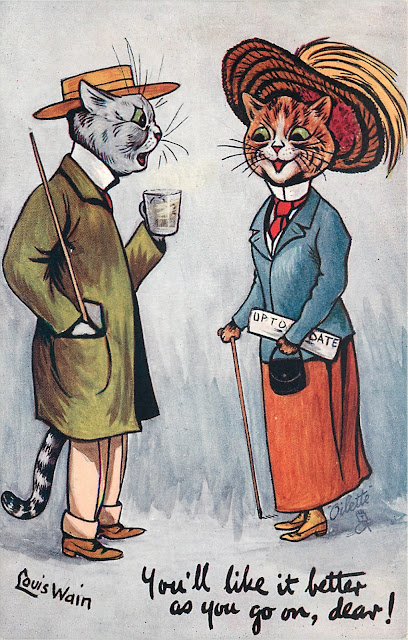How the works of Victorian artist Louis Wain raised the social status of cats in the modern world
- Lena Sharp
- Feb 10
- 3 min read
Updated: Feb 17
Book Review of Catland by Kathryn Hughes
By Lena Sharp
East-West Cultural Connections
Have you ever wondered how Kucinta the Singapore Cat, a much-loved drain moggie of dubious origins, came to be hailed as Singapore’s tourism mascot? This indomitable mouser now even has her own sculptures by the Singapore River.
Left: Straits Singapuras, CC BY-SA 4.0, via Wikimedia Commons;
Right: Cat Sculptures near Cavenagh Bridge, Singapore River, via Wikimedia Commons
For most of human history, cats were regarded as anonymous pest-removers and scavengers found wandering in back streets and yowling in alleys. Thus, Kucinta’s rise to stardom in modern Singapore reflects a global trend in the changing perception of cats. From the streets of Singapore to the couches of Great Britain - bob-tailed, bushy-tailed, tortoise-shelled or striped, these furry felines have somehow won the world over.
What brought about this change in attitude towards the feline species? The answer lies in the enchanting pages of Kathryn Hughes’ Catland – a journey through the ‘social history’ of cats. This historical account is masterfully interwoven with the imaginary world of Louis Wain – the Victorian artist whose cat illustrations contributed to the stratospheric rise of felines from basement pest chasers to pampered house pets.

Wain’s kitschy, fanciful illustrations depicted a world in which cats walked upright like humans, often wore human clothes, went shopping, met in pubs and mingled with high society, draped in finery. In Wain’s world, cats no longer had “weaselly faces and ratty tails” – instead, their faces were cuter, their eyes rounder and their tails fluffier than their real-world counterparts.
Anthropomorphised animals such as Mickey Mouse and Peter Rabbit have appeared in children’s books and on TV screens for generations – sporting clothes, walking like humans, drinking tea and wielding cricket bats. But long before they arrived, Louis Wain’s charming cats were already living it up in human style, creating a unique cat-culture described in great depth in Catland.

The author identifies the influence of Wain’s imaginative career on the real world – tracing the shift in attitudes between 1870 and 1939 when cats took the leap from scrounging on scraps to dining in parlours.
Catland is also a social commentary on a rapidly modernising, post-industrial Britain where the whole world (and not just the feline world) was transforming beyond recognition at a breakneck pace. Thanks to advancements in media and printing technologies, Wain’s works and popularity proved a commercial success - spreading globally throughout the British Empire in its heyday. His cats appeared everywhere, across all media, doing everything – selling shoes and soaps in poster ads, making political and patriotic statements on postcards, and engaging in domestic spats in newspaper comic strips.
Left: "You'll like it better as you go on dear!," Raphael Tuck "Oilette" postcard, via https://poulwebb.blogspot.com/
Right: Cats by the Seaside, via Tumblr

Out of Wain’s imaginary world, a real-world feline paradise was born, ushering in the ‘age of the cat’ as we know it today. Cat-lovers soon started emulating dog-breeders by selectively breeding their choice pets and organising cat shows to parade them to the public.
Whilst the fortunes of felines rose significantly during those years, Wain’s own fortunes sadly suffered highs and lows due to his deteriorating health - but not even at his lowest ebb did it stop his creativity. He continued to draw and paint till the very end, lighting up his hospice-home with psychedelic depictions of cats.
Although Louis Wain is hardly remembered now, his influence lives on in the ‘catland’ we inhabit today – the legacy of a genius whose love for cats shone through his work, melting hearts and re-shaping attitudes towards his furry friends.
"He had made the cat his own. He invented a cat style, a cat society, a whole cat world…."
Science-fiction writer H. G Wells on Louis Wain

 | Lena Sharp is a freelance writer who was born in Singapore and resides in the UK. She enjoys exploring cross-cultural connections that bridge the two worlds she inhabits - whilst taking others on a journey of discovery through her contributions. |












Comments